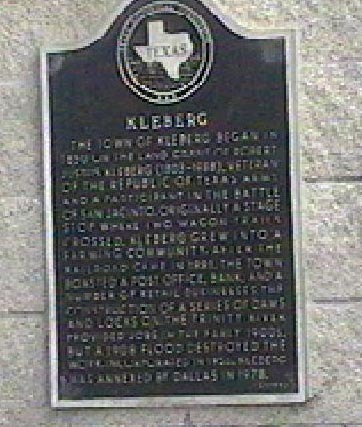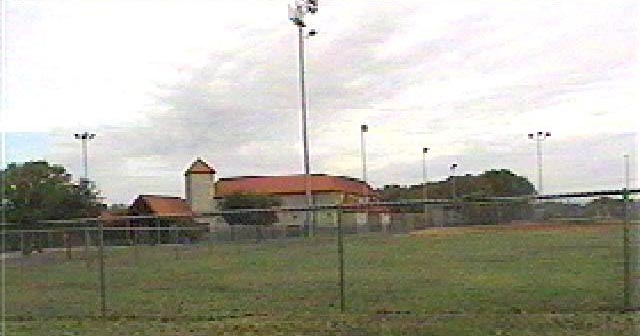Researched and Written
by Frances James
The town of Kleberg was named for Robert Justus Kleberg, who was awarded a league of land for his participation in the War for Independence from Mexico. Klegerg had fought in the battle at San Jacinto. This parcel of land was Survey No. 716. Robert Kleberg was born in Germany in 1803 and married Rosa Von Roeder there before coming to -America. In her memoirs Rosa recalled that they lived on Galveston Island until a bad storm blew their house ; She insisted thay go inland, and eventually they founded a settlement called Cat Springs in Austin County in 1844. Robert Kleberg died in 1888 and is buried at Yorktown, Texas. The name of Kleberg is well known in South Texas, and Kleberg County was named in his honor. In 1913. The King Ranch came into Kleberg control when King died and Kleberg's son, Robert, was asked by Mrs. King to manage the hugh cattle operation. There is no record that Robert Justus Kleberg ever visited or lived in Dallas County.
The proximity of this land to the Trinity River allowed the area to be mined for sand and gravel. Many small lakes and ponds remain as evidence of thisoperation. At the time of early settlement most of the terrain was covered with tall native grasses and trees, which existed largely in relation to the streams. The trees consisted mostly of elm, ash, pecan, cottonwood, pin oak, and other species of oak. Squatters, living in tents, stripped the heavily wooded land surrounding the community. Historians speculate this caused Kleberg to sell his league, as he could not control the destruction of the trees. The pin oak and post oak were needed for ties when the rail lines came to this part of Texas.
Fast growing Dallas needed the lumber from the piney woods of East Texas. In early 1878, a railroad organized and was called the Dallas Palestine and South­east Railroad Co. Among the charterers were Alex Sanger, C.A. Keating, S.W.S. Duncan, C.B. Buckner, W.H. Gaston, W.C. Conner, and Jules Schneider. For some reason not of record, they abandoned this charter and took out another one on November 6 of the following year under the name of the Texas Trunk Railroad Company to build to Beaumont through the East Texas territory. Work got underway and by August 1881 there were thirty-six miles of line in operation, Later fifteen more miles were laid to Cedar, changed to Gossett in honor of the principal farmer in the area. This little railroad had the distinction of having had more receivers than any other railroad in Texas: seven. By 1895, its stock formally passed into the hands of the Southern Pacific. Along with lumber from the East Texas sawmills, cotton was shipped to the compresses in Dallas.
Now the community of Kleberg was on a rail line and was beginning to grow. A post office was established in 1882, at which time the town was known as Klebergh. The first name change came when the 'h' was dropped in 1887. In 1926, the spelling was again changed to its present Kleberg. The originalnine acre town plat was recorded in 1899. At one time there was a bank, a hardware store, drug store (with a marble counter), a dry goods store, newspaper, barn and livery stable with a blacksmith shop nearby. The Woodman of the World met upstairs over the hardware store.
By 1905 the community was thriving. The United States Government had allocated $2 million dollars for improvements on the Trinity River. To enable navigation 12 of the Trinity, a series of locks and dams was included in the expenditure.
Lock No. 2 was near the town of Kleberg and many new people moved into the area. Bell and Carder were awarded the contract to build the locks, and at least one hundred people were employed. These people, from all over the world -- Germany, Poland, and Mexico -- plus local citizens, soon occupied every house and room available. Some even lived in tents. A short rail line, known locally as the "Dinky RR", was constructed to haul equipment and material to the site as well as workers. Much work had been completed by 1908 when a devastating flood 18 hit Dallas County, and the locks were washed away. It took several months for the water to recede so that work could resume. By 1915, Congress stopped funding the project, deciding it was no longer feasible. A dream that started with John Neely Bryan was finally abandoned. Today, there are still traces of these concrete locks along the Trinity.
In the meantime the railroads had lowered the rates, and the rail line was available. During this flurry of activity the town of Kleberg acquired a depot and a two-story red brick school house plus homes built by local residents. The train delivered freight and passengers twice daily as it passed through town. A passenger could ride from Dallas to Seagoville for 35cents one way. In 1920 the downtown section of Kleberg was destroyed by fire.; Part of the buildings were rebuilt. Mr. Olin Glenn, born in 1895 and mayor from 1955-1963, recalls, "I built back three of them myself." Mr. Glenn still lives with his wife, Flossie,in the home built by his mother and father in 1910.
The red brick school house served the town from 1913 until 1984. As the elementary school population increased, portable buildings were added until no play area was left for the children. Since the Dallas Independent School District assumed responsibility for the school system (in 1978), the children are now bused to Rylie Elementary School. A new building is scheduled for completion in 1987.18( update a New school was opened in 1987 on edd rd only a 1 mile from the old one)
One of the earliest teachers in the school was Miss Lois V. Rawlins from Lan;caster. She roomed with a German family in 1914-15 school year. Her son, Judge Newton Fitzhugh, remembers the Chow Chow recipe she used as having been 19 given to her by the German housewife. It is still used by his family.
The town of Kleberg was incorporated in 1956 and some city services were pro;vided for a limited area. High grade water from Dallas County Water Control District 7 was acquired as well as dial telephones and a new fire truck. Plans for a new city hall and sewage system were developed.-A master plan and new zoning ordinances were also drawn up.
In 1986 about all that is left of the old town of Kleberg are a few slabs ofconcrete and several well kept homes like the one built by Dr. J.W. Ridgell 21 amd M.C. Glenn.; Situated in the southeast corner of Dallas County, it is just a matter of time before the rural character will be lost. A new Inter­state Highway 20 is cutting through this area, and new residents are discoving the pleasure of living in a rural atmosphere within the city limits of Dallas. Large desirable tracts of land are awaiting quality development. A State Historical Marker for this crossroad community will enable the new residents of the area to appreciate the history of this pioneer town.

1987

2.; Sam Street's Map of Dallas County
Map from Volume C & D, page 423, Survey Records, Dallas County, Texas John H. Cole, County Surveyor.
3. General Land Office - Austin, W.A. Ferris, surveyor
4. Southwest Quarterly No. 4, April 1898, page 297-302
"Some of My Early Experiences in Texas", by Rosa Von Reader Kleberg.
5. Handbook of Texas, Volume A-K , page 986.
6. Dallas County "Open Space Report" compiled by Marvin Springer, 1980.
7. Pioneers of Yesteryear, published 1974, by Sfcells Vinson Bryant -Memoirs of Oscar Levi Horton, page 99.
8. Reed, S.G. , A History of the Texas Railroads and of Transportation Conditions Under Spain and Mexico and the Republic and the State (Houston: St. Clair Publishing Co. , 1941 page 230-235.
9. History of Kleberg Post Office, 1882-1976 compiled from local records.
1Q. Original Town of Kleberg plat filed for record January 1 , 1899 Vol. 232, page 19, Dallas County Records.
11. Interview with Mr. Olin Glenn, Mayor of Kleberg 1956-1962, born in Kleberg in 1896 and still lives in the family home on Kleberg Road.
12. E.H. Brown, Trinity River Canalization, Dallas: Trinity River Improvement Association, 1930, page 37.
13. Interview with Mr. Olin Glenn, 1984. Private papers of Frances James.
14;; The Southeast Journal, September 2, 1970 "Worker Returns to Trinity Canal".
15. Dallas Morning Mews, Sunday, November 30, 1986, Fsection, page 2. 16 Dallas Times Herald, April 9, 1975 "No Respite for Kleberg". 17. Interview with Olin Glenn, 1984.18. Dallas Independent School District, Administration. Dale Fidler, planner.
19. Interview with Judge Newton Fitzhugh, Dallas County Historical Commission member 1980-1986.
20. Dallas Times Herald, Monday, December 7, 1959 - Dallas County Mayors. Interview with Mrs. Lillian Higgins, December 1986, Mr. Eugene Higgins was chairman of the Water Board.
21. Photographs of homes, Kleberg Road, taken by Mary Krueger.
Improvement Association, 1930. Dallas City Council Minutes, June 28, 1978. City Secretary File,
City Hall, Dallas, Texas. Dallas County Deed Records
Dallas County - Open Space Report, prepared by Marvin Springer
Associates, 1980 Dallas County Survey Records Dallas Independent School District - Administration Dallas Morning News Dallas Times Herald
General Land Office Records - Austin Handbook of Texas
Interview with Judge Newton Fitzhugh Interview with Olin Glenn Interview with Mrs. Eugene (Lillian) Higgins Pioneers of Yesteryear, by Stella Vinson Bryant, published 1974 Reed, S.G. A History of Texas Railroads and of Transportation
Conditions Under Spain and Mexico and the Republic and the
State (Houston: St. Clair Publishing Co., 1941) Southwestern Quarterly No. 4 , April 1898 Southeast Journal, September 2, 1970 United States Post Office Records - History of Kleberg Post Office 1882-1976
Sam Street's Map of Dallas County 1900
;Photographs of homes by Mary Krueger - Dallas
Letter from King Ranch
KING RANCH. INC.
JOHN a ARMSTRONG EXECUTIVE VICE PRESIDENT
W.B. YAR80ROUGH VCE PRESIDENT
STEPHEN J. KLEBERG VCE PRESIDENT SECRETARY & TREASURER
RONALD L KELLETT ASSISTANT SECRETARY
LEROY G. DENMAN, JR. GENERAL COUNSEL
Mrs. Frances James 4322 St. Francis Ave. Dallas. Texas 75227
Dear Mrs. James:
Your letter of February 1st to Texas A & I University has been forwarded to roe.
I am enclosing a short biography on the Kleberg Family of the time of Robert Justus Kleberg.
M.E. Kleberg, Marcellus Eugene Kleberg, was the brother of Robert Justus Kleberg.
I would suggest your getting a copy of the book THE GOLDEN FREE LAND by Crystal Sasse Ragsdale, Landmark Press, Austin, Texas 1976.
Hope this information is-helpful to you on your Historical project.
W.E. Sellers
WES/bb enclosure